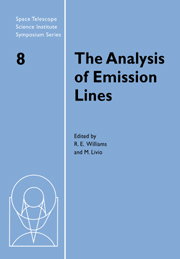Book contents
- Frontmatter
- Contents
- Participants
- Preface
- Emission Lines: Past and Future
- Atomic Data for the Analysis of Emission Lines
- Radiative Transfer
- Emission Lines from Winds
- Photoionizing Shocks
- The Lexington Benchmarks for Numerical Simulations of Nebulae
- Emission Line Diagnostics
- Ultraviolet Spectroscopy
- Infrared Emission Lines as Probes of Gaseous Nebulae
- Molecular Emission Line Diagnostics in Astrophysical Environments
- Abundance Determinations
- Astrophysical Gamma Ray Emission Lines
- Summary Remarks
Infrared Emission Lines as Probes of Gaseous Nebulae
Published online by Cambridge University Press: 23 November 2009
- Frontmatter
- Contents
- Participants
- Preface
- Emission Lines: Past and Future
- Atomic Data for the Analysis of Emission Lines
- Radiative Transfer
- Emission Lines from Winds
- Photoionizing Shocks
- The Lexington Benchmarks for Numerical Simulations of Nebulae
- Emission Line Diagnostics
- Ultraviolet Spectroscopy
- Infrared Emission Lines as Probes of Gaseous Nebulae
- Molecular Emission Line Diagnostics in Astrophysical Environments
- Abundance Determinations
- Astrophysical Gamma Ray Emission Lines
- Summary Remarks
Summary
Infrared emission lines are just coming into their own as diagnostic tools for the study of gaseous nebulae. Various infrared line ratios provide the means to determine physical parameters such as extinction, density, temperature, and ionic and elemental abundances. In certain regimes, infrared lines provide essentially the only opportunity for determining these parameters, or even for detecting the gas. Examples include regions of high extinction, low temperature, and predominantly neutral material. I review the general properties of infrared emission lines and their characteristics as nebular diagnostics, and cite a number of illustrative applications. The latter are drawn from a wide range of fields, including star formation and H II regions, planetary nebulae, nova and supernova remnants, shocked and photodissociated gas, and AGN and star burst galaxies.
Introduction
The phrase “infrared emission lines,” like so many other topics covered at this meeting, is extremely broad. Therefore I will begin by defining and limiting the scope of this review. I will discuss only lines that arise from gas-phase atoms, ions, and molecules, and will not include spectral features produced by interstellar dust. In this review, “infrared” will mean the spectral region 1–200 μm, which corresponds to certain types of astronomical detectors; shorter wavelengths will be called “far red” (with apologies to Don Osterbrock), and longer wavelengths, “submillimeter.” Another boundary condition is that I will restrict myself to low densities, n ≤ 108 cm–3. Apart from these constraints, I will attempt to be as general as possible, though with no pretentions to completeness. This review is organized by physical properties and methods of analysis, rather than by class of astronomical object.
- Type
- Chapter
- Information
- The Analysis of Emission Lines , pp. 134 - 157Publisher: Cambridge University PressPrint publication year: 1995
- 8
- Cited by



